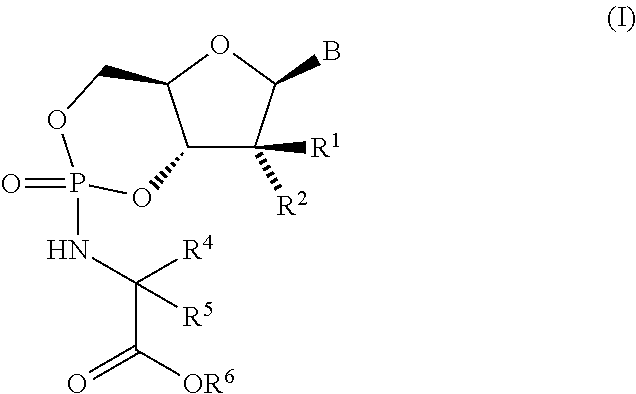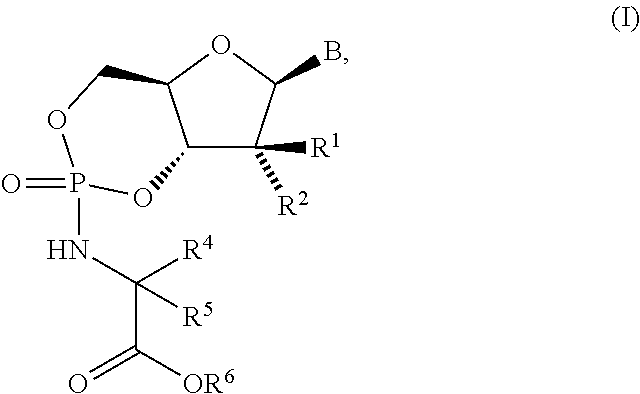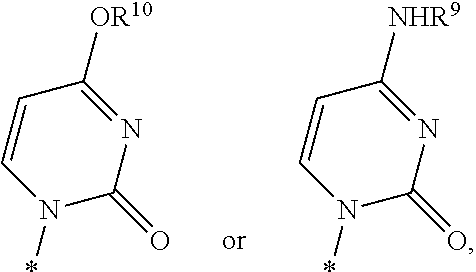Nucleoside cyclic phosphoramidates for the treatment of RNA-dependent RNA viral infection
a technology of rna-dependent rna virus infection and nucleoside cyclic phosphoramidates, which is applied in the field of nucleoside cyclic phosphoramidates, can solve the problems of limited clinical benefit, no established vaccine for hcv, and treatment of hcv infection, and achieves less susceptible, wide therapeutic index, and efficient target cell penetration
- Summary
- Abstract
- Description
- Claims
- Application Information
AI Technical Summary
Benefits of technology
Problems solved by technology
Method used
Image
Examples
example 1
[0112]Step 1: n-Butyl N-[chloro(4-chlorophenoxy)phosphoryl]-L-alaninate
[0113]To 4-chlorophenyl dichlorodiphosphate in DCM (0.16 M) was added (2S)-1-butoxy-1-oxopropan-2-aluminium chloride (1.0 eq), after cooling to −78° C., Et3N (2.0 eq.) was added neat and the reaction was left to warm to room temperature overnight. All volatiles were removed and the resulting white solid washed with Et2O, filtered and evaporated in vacuo to obtain a colourless oil as a 1:1 mixture of diastereomers. 31P NMR (400 MHz, CDCl3): 9.5 and 9.3 ppm.
Step 2: n-Butyl (2S)-2-{[{[(2R, 3R, 4R, 5R)-5-(4-amino-2-oxopyrimidin-1(2H)-yl)-3,4-dihydroxy-4-methyltetrahydrofuran-2-yl]-methoxy}-(4-chlorophenoxy)phosphoryl]-amino}propanoate
[0114]2′-C-Methylcytidine (evaporated twice from toluene) was diluted with THF (0.097 M). The resulting slurry was cooled to −78° C., then tert-butylmagnesium chloride (as 1.0M solution in THF, 2.0 eq.) was added. The mixture was immediately warmed to 0° C., stirred for thirty min and ag...
example 2
[0118]Step 1: Ethyl N-[chloro(4-chlorophenoxy)phosphoryl]-L-alaninate
[0119]Following the procedure described for Step 1 of Example 1, treatment of a DCM (0.16 M) solution of para-chlorophenyl dichlorodiphosphate with L-alanine ethyl ester hydrochloride (1.0 eq.) and Et3N (2.0 eq.) provided the title compound as a colourless oil as a 1:1 mixture of diastereomers.
31P NMR (300 MHz, CDCl3): δ 9.43 and 9.11 ppm.
[0120]Step 2: Ethyl (2S)-2-{[{[(2R,3R,4R,5R)-5-(4-amino-2-oxopyrimidin-1(2H)-yl)-3,4-dihydroxy-4-methyltetrahydrofuran-2-yl]methoxy}(4-chlorophenoxy) phosphoryl]amino}propanoate
[0121]Following the procedure described for Step 2 of Example 1, 2′-C-methylcytidine (evaporated twice from toluene) in THF (0.097 M) was cooled to −78° C., then tert-butylmagnesium chloride (as 1.0M solution in THF, 2.2 eq.) was added, followed by the addition of ethyl N-[chloro(4-chlorophenoxy)phosphoryl]-L-alaninate (as a 1.0M solution in THF, 2.0 eq.). The crude was purified by column chromatography on ...
example 3
[0125]Step 1: n-Heptyl N-[chloro(4-chlorophenoxy)phosphoryl]-L-alaninate
[0126]Following the procedure described for Step 1 of Example 1, treatment of a DCM (0.098 M) solution of para-chlorophenyl dichlorodiphosphate with L-alanine n-heptyl ester hydrochloride (1.0 eq.) and Et3N (2.0 eq.) provided the title compound as a colourless oil as a 1:1 mixture of diastereomers.
31 P NMR (300 MHz, CD3OD): δ 9.5 and 9.2
[0127]Step 2: n-Heptyl (2S)-2-{[{[(2R,3R,4R,5R)-5-(4-amino-2-oxopyrimidin-1(2H)-yl)-3,4-dihydroxy-4-methyltetrahydrofuran-2-yl]methoxy}-(4-chlorophenoxy) phosphoryl]-amino}propanoate
[0128]Following the procedure described for Step 2 of Example 1, 2′-C-methylcytidine (evaporated twice from toluene) in THF (0.097 M) was cooled to −78° C., then tert-butylmagnesium chloride (as 1.0M solution in THF, 2.2 eq.) was added, followed by the addition of n-heptyl N-[chloro(4-chlorophenoxy)phosphoryl]-L-alaninate (as a 1.0M solution in THF, 2.0 eq.). The crude was purified by column chromato...
PUM
| Property | Measurement | Unit |
|---|---|---|
| Molar density | aaaaa | aaaaa |
| Molar density | aaaaa | aaaaa |
| Molar density | aaaaa | aaaaa |
Abstract
Description
Claims
Application Information
 Login to View More
Login to View More - R&D
- Intellectual Property
- Life Sciences
- Materials
- Tech Scout
- Unparalleled Data Quality
- Higher Quality Content
- 60% Fewer Hallucinations
Browse by: Latest US Patents, China's latest patents, Technical Efficacy Thesaurus, Application Domain, Technology Topic, Popular Technical Reports.
© 2025 PatSnap. All rights reserved.Legal|Privacy policy|Modern Slavery Act Transparency Statement|Sitemap|About US| Contact US: help@patsnap.com



